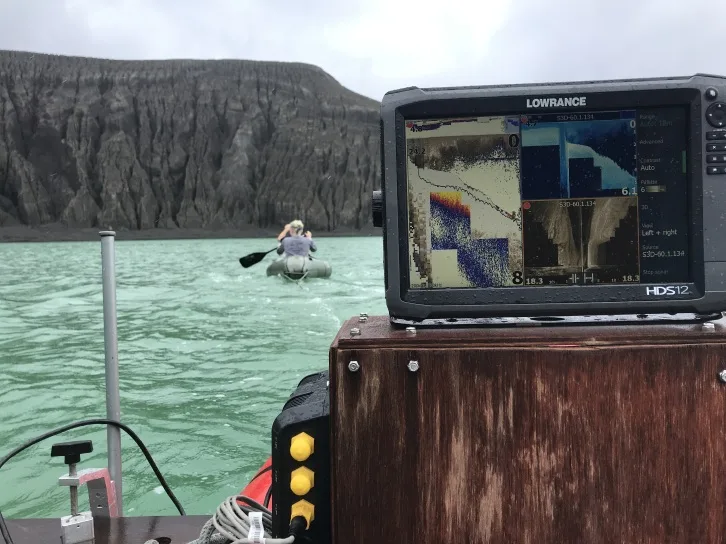Programs Blog
“Another Planet:” Exploring Hunga Tonga-Hunga Ha’apai

Ship’s Log
Location
HTHH Hunga Tonga-Hunga Ha’apai
Weather
Cloudy and rainy
Hello from the newest land mass on earth! I’m Grace, and today was my first day on Hunga Tonga Hunga Ha’apai. (I spent yesterday on the ship, helping to ensure that our anchor wouldn’t slip and allow us to be blown out to sea.) After breakfast and a community meeting on the quarterdeck, I boarded our small rescue boat and was whisked ashore. The sky was blanketed with clouds that occasionally pelted us with rain, a fact which under normal circumstances would have been disappointing, but the weather made the pitch black sand of the beach more intense and the volcano itself, pitted with deep ravines, all the more striking. As I walked across this otherworldly landscape, it was easy to convince myself that I had stumbled onto another planet. That is until a barn owl swooped past me, shattering this illusion. (We believe these owls are eating the rats we have observed on the island, and there is still so much more to discover about the animals here!)
 cliffs and surf on the south shore.
cliffs and surf on the south shore.
My first task of the day was to hike to the crater lake on the other side of the tuff cone in order to conduct a plankton net tow and to complete the last of the side-scan sonar transects that will allow us to map the contours of the lake basin. We inflated our two rafts, and paddled across the mint green lake, dragging a very fine mesh net behind us. This gave us a concentrated sample of any organisms larger than 60 microns in the lake. Our water samples from yesterday show that the lake is more acidic than the ocean around it, so it will be fascinating to see what organisms have colonized these waters. We have looked at our net tow sample using our ship microscopes, and so far have identified spindly diatoms and barnacle nauplii (larvae)!
Next up, we fixed a sonar device and GPS to one of the inflatable rafts, and towed that across the lake several times. These transects will hopefully allow us to map the bathymetry of the lake itself! In the process of handling and paddling the rafts, I managed to submerge myself up to my chest several times, and eventually gave up on being completely dry ever again. After all this walking, paddling, and hauling of equipment we were all quite ready to head back to the beach and meet the other research teams for lunch.
After lunch, I joined the geosurvey team on a hunt for geothermal hotspots in the ravines that scar the sides of the volcano. Dan Slayback, who has joined us from NASA for this mission, brought along his heat-sensing thermal imaging camera for this purpose. Though we did not succeed today in finding any hotspots, we had fun exploring the ravines and collecting images of interesting rocks for our geologic catalog. On our way back to our home base, we went around the south shore of the island and marveled at the steep, jet black cliffs above us and the raging surf below. We also saw several baby whales happily showing their tails in the waters just off the coast!
As the rescue boat ferried people back to the Seamans in small groups, I decided to go for a swim. Floating in the water with the magnificent volcano looming in front of me, I thought about coming back tomorrow. Hopefully I will hike to the very top of the crater in order to collect samples that will provide vital clues about the soil microbiome of this brand new island. I also want to pick up more of the plastic trash that litters the island, giving back to this place that has already taught us so much. But for now it’s back to the ship, dry clothes, dinner, and another round of planning before bed. Thank you Hunga Tonga-Hunga Ha’apai for your unearthly beauty and for helping us better understand the workings of our Earth and other planets beyond it. I can’t wait to return.
– Grace Callahan, Wellesley College
See also: NASA Earth Expeditions Blog
Recent Posts from the Ships
- Ocean Classroom 2024-A collaborative high school program with Proctor Academy
- Collaborations and Long-term Commitments: SEA’s Caribbean Reef Program Sets a Course for Coastal Programs that Compliment Shipboard Experiences.
- Sea Education Association students prepare for life underway using state of the art nautical simulation from Wartsila Corporation.
- SEA Writer 2022, Magazines From the Summer SEA Quest Students
- Technology@SEA: Upgrades Allow Insight into Ocean Depths
Programs
- Gap Year
- Ocean Exploration
- High School
- Science at SEA
- SEA Expedition
- SEAScape
- Pre-College
- Proctor Ocean Classroom
- Protecting the Phoenix Islands
- SPICE
- Stanford@SEA
- Undergraduate
- Climate and Society
- Climate Change and Coastal Resilience
- Coral Reef Conservation
- Marine Biodiversity and Conservation
- MBL
- Ocean Exploration: Plastics
- Ocean Policy: Marine Protected Areas
- Oceans and Climate
- Pacific Reef Expedition
- The Global Ocean: Hawai'i
- The Global Ocean: New Zealand